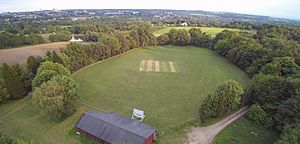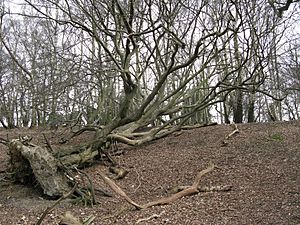South Weald Camp facts for kids
South Weald Camp is an ancient hillfort located in South Weald, near Brentwood, Essex, England. It was a round fort, about 2.8 hectares (the size of about 4 football fields). People think it was built a long, long time ago, during the late Iron Age (around 100 BC to 100 AD). Two ancient tribes, the Catuvellauni and the Trinovantes, lived in this area back then.
The camp had strong defenses, like a big earth wall (called a rampart) and a steep slope. There were also signs of a ditch outside. After the Iron Age, the camp wasn't used much for a while. Later, in the medieval period, it became part of a deer park. Much later, during WWII, it was used as a training ground for soldiers. Today, a road called Sandpit Lane cuts through the fort. Part of it is now in Weald Country Park, and the other part is used by the South Weald Cricket Club.
Contents
Discovering the Past: Archaeology at South Weald Camp
Scientists have studied South Weald Camp to learn more about its history. In 1995, two important reports came out. One was a survey of the land, and the other shared what they found from digging two trenches in 1990. These studies helped us understand the camp better. They found evidence of four main periods of activity at the site.
What Was the Iron Age Hillfort Like?
Experts describe South Weald Camp as a simple hillfort with one main defense. It sits on a gentle hillside, about 98 to 102 meters above sea level. A road cuts through the old earth walls, and the western side is now covered by woodland. The fort was almost perfectly round and had a single bank and an outer ditch. It covered about 2.8 hectares.
Today, you can still see some of the old earthworks on the western side. The slope between the inner bank and outer ditch is up to 3 meters high. In other places, the leveled bank is just a slight change in the ground. The ditch is partly filled in now, but in some areas, it's still hidden underground.
When they dug trenches in 1990, they found the ditch was about 3.4 meters wide and 1.4 meters deep. It had steep sides that narrowed to a flat bottom about 1.5 meters wide. They found pottery pieces near the bottom of the ditch. These pieces were from the 1st century BC to the 1st century AD. This suggests the ditch was built in the late Iron Age. The ditch was dug out again between the 10th and 12th centuries AD.
There was one entrance on the south side, with a slightly curved-in end on the east. Behind the main earth wall, they found a long, narrow slot. Inside it were charcoal, burnt clay, and burnt stones. This might have been part of a support structure for the wall. They also found some postholes, which are holes where wooden posts once stood. Today, a cricket ground and pavilion are located inside the north-east part of the old fort.
How Was the Camp Used in Medieval Times?
There is proof that during the medieval period, much of the ditch was changed. It was made to fit a new purpose. One idea is that the shape of the Iron Age earthwork was used as a boundary for a deer park. Extra earthworks were added to the west to include a pond within this park.
From the 16th to the 20th Century
The deer park at South Weald was used until 1939. However, areas to the north-west were dug up for sand and gravel. This was likely used to build roads. The park became part of the land belonging to Weald Hall. There is also evidence of a lot of landscape gardening. This probably included removing or flattening some of the fort's earth walls.
South Weald Camp in Modern Times (20th–21st Century)
During the Second World War, the area was used for military training. It was also used for growing vegetables (allotment fields). This caused a lot of damage to the old archaeological site and the remaining earthworks. In 1975, a gas pipe was put across the part owned by the cricket ground. No ancient structures or finds were reported then.
In 1990, Essex County Council allowed a small research dig. This happened on the western part of the earthwork (in Weald Country Park). During this dig, several items were found. These included burnt clay, worked flint, and pottery. After the war, the eastern part of the site was leveled. This was done to create the cricket pitch. Only small landforms can still be seen on the western side.
Protecting South Weald Camp
South Weald Camp was listed as a Scheduled Monument in January 1955. This means it's a very important historical site that needs protection. It's rare to find slight univallate hillforts in the UK, especially in eastern England. Even though parts of the ditch are filled in, experts believe South Weald Camp could still hold more archaeological secrets. It is considered a site of national importance.



